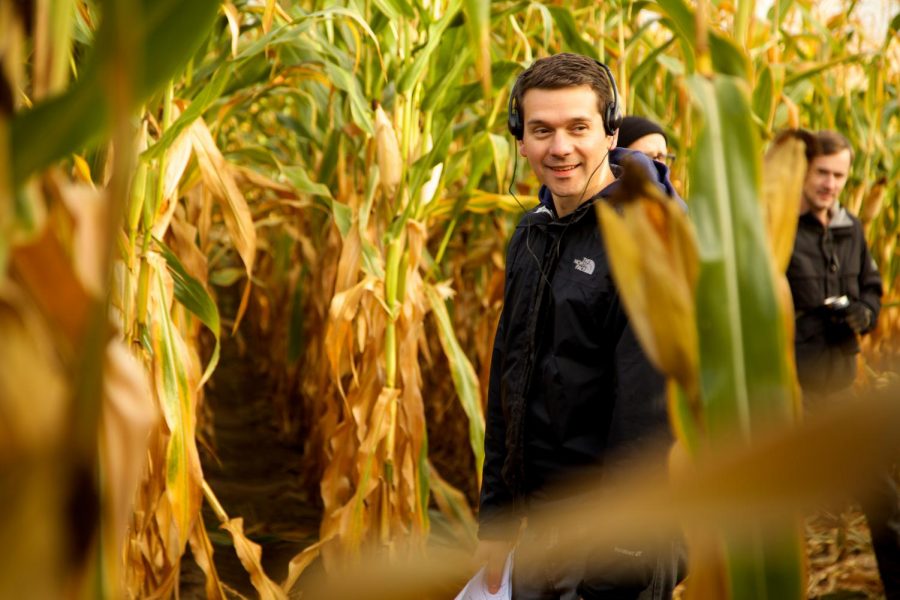‘Green Room’ director Jeremy Saulnier talks Nazi punks
“Green Room” is the third feature film from writer-director Jeremy Saulnier.
April 18, 2016
Punk-rock thriller “Green Room” is the third feature film from writer-director Jeremy Saulnier. The ensemble cast of fresh-faced newcomers plays off veteran actor Patrick Stewart as Darcy, the owner of a white-supremacist bar in the backwoods of Oregon.
The film follows “The Ain’t Rights,” a band of makeshift punk rockers, as they become increasingly embroiled in the violent affairs of Darcy and his neo-nazi flunkies.
Saulnier, once an amateur musician himself, drew fromhis experiences in the punk-rock scene, as well as borrowing from an eclectic mixture of horror, war, and base-under-siege films from the 1980’s to direct “Green Room.”
The Chronicle spoke with Saulnier about his punk-rock roots, his influences and the political relevance of “Green Room.”
THE CHRONICLE: This isn’t an overtly political film, but given some of Donald Trump’s recent remarks, it does strike a chord. Was “Green Room” politically motivated in any way?
JEREMY SAULNIER: There are certainly some undertones. Unfortunately, I wrote this script two years ago. I was shocked to see how relevant it’s become, and I’m disappointed. The initial feedback I got on my script was that it was a weird throwback to the 1980’s or [1990’s], which it was. “The Ain’t Rights” are in their van on the last leg of a tour, and they are scavengers trying to find the last remnant of a vibrant scene. It just so happens that Portland, Oregon, does have a history of certain groups outside in the rural area that are very much white-power oriented. So, it seems like it was very much the place to set it. I had no idea that these militant groups would besiege us. I didn’t see [Donald] Trump coming. I did see a very disturbing trend in American conservative power structures, and that certainly plays into the organization of our skinhead gang. It’s about people on the top of the food chain, people on the bottom of the food chain, who’s doing what to [whom], who’s causing the carnage and who’s paying the price. That certainly relates to the American political landscape. That was something that I was aware of as I was writing. Of course, the primary goal was just badass entertainment.
How did you create the film’s comic atmosphere without being too campy?
I think it comes across as natural to the grim situation. I really don’t try to inject it when I’m writing. I just try to let it happen. If the exchange seems authentic, I’ll let it happen. I never try to purposely insert a funny moment; I find them naturally. They seem effortless because they are. They are found, not created.
Did you aim to depict the punk scene in any particular light?
I just wanted to be true to my experience. It’s about a love. If you’re in a punk band, it’s unlikely that you’re turning down record deals left and right. You’re probably just playing somewhat pathetic shows, but you give it your all regardless. You’re not there for money or accolades; you’re just there for the experience.
How did Patrick Stewart get involved in the film?
I did not have him in mind for Darcy. I wasn’t aiming that high. I wrote the character, and I was expecting some other character actor to come play the part because I didn’t think that people of his stature would be interested in making this kind of movie. The casting process was very difficult. We were two weeks out from production with no lead bad guy. It just so happened that he had joined my management company, and an assistant there suggested his name. As soon as that was an option, we pounced. We got on the phone, and I followed up with a more detailed character history for him to latch onto, and it was rapid-fire. Suddenly, he was flying to Portland to be Darcy, and it was insane. I was bracing for impact, but he just showed up like any other actor and brought his craft. He was very generous.
Were there any other films that influenced “Green Room?”
“Straw Dogs” was a key influence. It was a very fulfilling cinematic experience with an incredibly thin plot. It was about experience and atmosphere. John Carpenter’s “The Thing” is another one for the same reason. It builds tension in a closed space, and the make-up for that movie has influenced my entire career. It’s just amazing. “River’s Edge” influenced the tone. That’s a northwest heavy metal movie involving a murder. “Apocalypse Now” is an interesting film because it’s a huge, epic film, but the finale is small-scale compared to the rest of it.
“Green Room” is scheduled to open in Chicago theaters on April 22.








